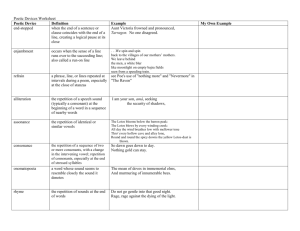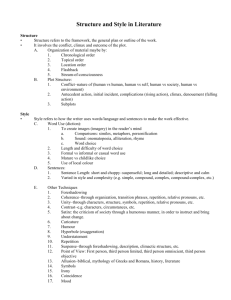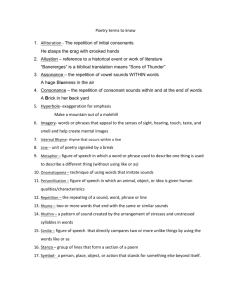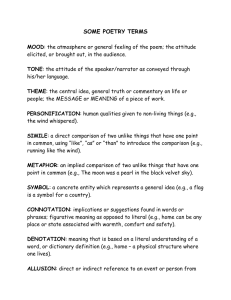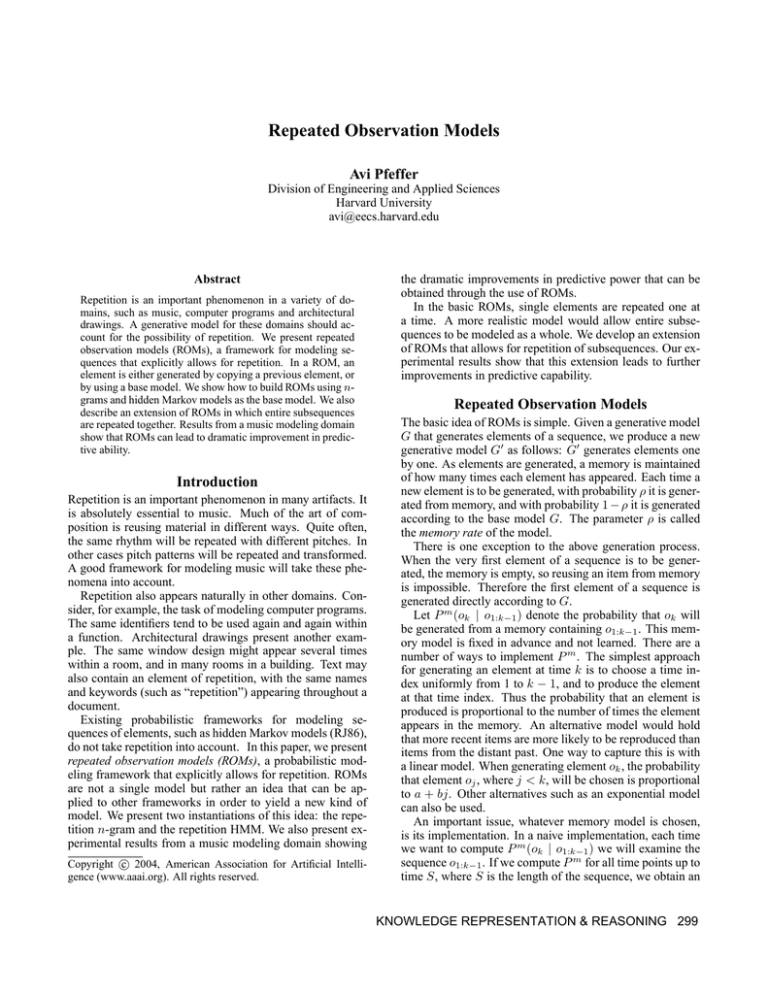
Repeated Observation Models
Avi Pfeffer
Division of Engineering and Applied Sciences
Harvard University
avi@eecs.harvard.edu
Abstract
Repetition is an important phenomenon in a variety of domains, such as music, computer programs and architectural
drawings. A generative model for these domains should account for the possibility of repetition. We present repeated
observation models (ROMs), a framework for modeling sequences that explicitly allows for repetition. In a ROM, an
element is either generated by copying a previous element, or
by using a base model. We show how to build ROMs using ngrams and hidden Markov models as the base model. We also
describe an extension of ROMs in which entire subsequences
are repeated together. Results from a music modeling domain
show that ROMs can lead to dramatic improvement in predictive ability.
Introduction
Repetition is an important phenomenon in many artifacts. It
is absolutely essential to music. Much of the art of composition is reusing material in different ways. Quite often,
the same rhythm will be repeated with different pitches. In
other cases pitch patterns will be repeated and transformed.
A good framework for modeling music will take these phenomena into account.
Repetition also appears naturally in other domains. Consider, for example, the task of modeling computer programs.
The same identifiers tend to be used again and again within
a function. Architectural drawings present another example. The same window design might appear several times
within a room, and in many rooms in a building. Text may
also contain an element of repetition, with the same names
and keywords (such as “repetition”) appearing throughout a
document.
Existing probabilistic frameworks for modeling sequences of elements, such as hidden Markov models (RJ86),
do not take repetition into account. In this paper, we present
repeated observation models (ROMs), a probabilistic modeling framework that explicitly allows for repetition. ROMs
are not a single model but rather an idea that can be applied to other frameworks in order to yield a new kind of
model. We present two instantiations of this idea: the repetition n-gram and the repetition HMM. We also present experimental results from a music modeling domain showing
c 2004, American Association for Artificial IntelliCopyright gence (www.aaai.org). All rights reserved.
the dramatic improvements in predictive power that can be
obtained through the use of ROMs.
In the basic ROMs, single elements are repeated one at
a time. A more realistic model would allow entire subsequences to be modeled as a whole. We develop an extension
of ROMs that allows for repetition of subsequences. Our experimental results show that this extension leads to further
improvements in predictive capability.
Repeated Observation Models
The basic idea of ROMs is simple. Given a generative model
G that generates elements of a sequence, we produce a new
generative model G0 as follows: G0 generates elements one
by one. As elements are generated, a memory is maintained
of how many times each element has appeared. Each time a
new element is to be generated, with probability ρ it is generated from memory, and with probability 1 − ρ it is generated
according to the base model G. The parameter ρ is called
the memory rate of the model.
There is one exception to the above generation process.
When the very first element of a sequence is to be generated, the memory is empty, so reusing an item from memory
is impossible. Therefore the first element of a sequence is
generated directly according to G.
Let P m (ok | o1:k−1 ) denote the probability that ok will
be generated from a memory containing o1:k−1 . This memory model is fixed in advance and not learned. There are a
number of ways to implement P m . The simplest approach
for generating an element at time k is to choose a time index uniformly from 1 to k − 1, and to produce the element
at that time index. Thus the probability that an element is
produced is proportional to the number of times the element
appears in the memory. An alternative model would hold
that more recent items are more likely to be reproduced than
items from the distant past. One way to capture this is with
a linear model. When generating element ok , the probability
that element oj , where j < k, will be chosen is proportional
to a + bj. Other alternatives such as an exponential model
can also be used.
An important issue, whatever memory model is chosen,
is its implementation. In a naive implementation, each time
we want to compute P m (ok | o1:k−1 ) we will examine the
sequence o1:k−1 . If we compute P m for all time points up to
time S, where S is the length of the sequence, we obtain an
KNOWLEDGE REPRESENTATION & REASONING 299
O(S 2 ) algorithm. A better solution is to precompute P m for
all time points using dynamic programming, obtaining an
O(S) algorithm. This can be accomplished for the constant
memory model, in which all we need to know is the number
of times an element has appeared, not the exact points at
which it has appeared. It can also be accomplished easily
for the linear model, by storing the total weight associated
with each possible element as the sequence is traversed.
It is important to emphasize that the observed variables do
indeed need to be observed in a ROM. If the repeating variables are hidden, inference becomes extremely difficult and
approximation methods are needed, because one has to sum
over all possible values of the repeating elements. Therefore
in this paper we assume that the elements of the sequence
are always observed, hence the name “repeated observation
model”. Furthermore, we restrict ourselves to discrete observations. While one could imagine an approximate notion
of repetition for continuous elements, exact repetition would
be a very rare occurence. We now present two examples of
RMs.
independently. To start with, z1 is always false. For k > 1,
we compute
P (zk = T, ok | o1:k−1 ) = ρP m (ok | o1:k−1 ),
P (zk = F, ok | o1:k−1 ) = (1 − ρ)P n (ok | ok−1:k−n+1 )
and choose the zk that results in higher probability.
Finally, we need an algorithm to learn the values of the
parameters from data. In a repetition n-gram the parameters
are the memory rate ρ and the n-gram parameters. A simple
version of expectation maximization (EM) (DLR77) will do
the trick. In the expectation step, we compute pik = P (zki =
T | oi1:S ) for each time point k in each training sequence
i. This is obtained simply by normalizing the results of the
above two equations. In the maximization step, we estimate
ρ to be the average over all time points > 1 in all sequences
of pik . Meanwhile, the n-gram parameters are estimated
by counting as usual, except that the n-gram ending with oik
only contributes a count of 1 − pik .
Repetition HMM
Repetition n-grams
H1
Z1
Z2
Z3
Zk
O1
O2
O3
Ok
H2
Z1
O1
H3
Z2
O2
Hk
Z3
O3
Zk
Ok
Figure 2: Dependency model for repetition HMM
Figure 1: Dependency model for repetition n-gram
We begin with repetition n-grams. Figure 1 shows the
dependency model in the form of a Bayesian network. We
see that the k-th observation ok depends on all the previous
k − 1 observations, because of generation from memory. We
also introduce a variable zk , which is true if ok is generated
from memory, false if it is generated according to the ngram probabilities. The probability that zk is true is ρ, the
memory rate of the model, for all k > 1.
In using ROMs, like other probabilistic sequence models,
we need a number of algorithms. The most basic algorithm
computes the probability of an observation sequence o1:T .
Let P n (ok | ok−n+1:k−1 ) denote the n-gram probability of
ok given the previous n − 1 observations. Then for k > 1,
P (ok | o1:k−1 ) =
ρP m (ok | o1:k−1 )+
(1 − ρ)P n (ok | ok−1:k−n+1 )
P (o1 ) is obtained from the unigram model. The probability of an observation sequence is simply the product
QT
k=1 P (ok | o1:k−1 ).
The next algorithm computes the most likely assignment
to hidden variables given an observation sequence. While
n-grams do not have hidden variables, repetition n-grams
do, namely the zk . To find the most likely assignment to
the zk , we note from Figure 1 that the zk are conditionally
independent of each other given the observation sequence.
Therefore we can choose the most likely value of each zk
300
KNOWLEDGE REPRESENTATION & REASONING
The repetition HMM is a more powerful model, allowing
for a hidden state that varies over time. As in an ordinary
HMM, the generative model produces a Markov chain of
hidden states, where the initial state is determined by the
initial model P 1 (h) and the transition probabilities are determined by the transition model P (h2 | h1 ). At each point
an observation is generated. With probability ρ it is generated from memory, and with probability 1 − ρ it is generated
using the observation model P (o | h). The Bayesian network structure for the repetition HMM, shown in Figure 2,
appears quite dense. The hidden states hk form a Markov
chain as in ordinary HMMs. Unlike ordinary HMMs, however, each observation depends not only on its hidden state
but also on the previous observations. The graph is thus
highly multiply connected. However, the graph hides a lot
of additional structure in the model in the form of contextspecific independence (CSI) (CBK96). CSI is a situation
in which two variables are independent of each other given
some values of a third variable and not others. In our case,
the context variables are the zk . If zk is true, then ok depends
only on the previous observations and not on its hidden state.
If zk is false, ok depends only on the hidden state hk . Thus
in no circumstances does an observation depend both on the
hidden state and its previous observations.
The first algorithm computes the probability of a sequence, and is analogous to the Forward-Backward algorithm for HMMs (RJ86). We present the backward version
of the algorithm here. It is similar in principle, but requires
some modifications to the HMM algorithm. The algorithm
computes fk (hk , zk ) = P (ok:S | hk , zk , o1:k−1 ) at each
time step. Note that unlike the HMM algorithm, all previous observations are included as conditioning factors for the
future observations. This is because it is no longer the case
that future observations are independent of past ones given
the hidden state. The computation proceeds separately for
the cases zk = T and zk = F . For zk = T ,
memory. It is only when the generation is not from memory
that we can learn from the coappearance of h and o. Once
we have estimated these statistics, the maximization step is
as one would expect. The only thing to note is that when
computing ρ, we only consider time points after the first, so
the denominator uses S i − 1:
fk (hk , T ) = P (ok:S | hk , zk = T, o1:k−1 )
=
P (ok | hk , zk = T, o1:k−1 )P (ok+1:S | hk , zk = T, o1:k )
=
m
P (ok | o1:k−1 )×
P
P (hk+1 | hk , zk = T, o1:k )×
hk+1 ,zk+1 P (z
k+1 | hk , zk = T, hk+1 , o1:k )×
P (ok+1:S | hk , zk = T, hk+1 , zk+1 , o1:k )
=
m
P
(o
|
o1:k−1 )×
k
P
hk+1 ,zk+1 P (hk+1 | hk )P (zk+1 )fk+1 (hk+1 , zk+1 )
For the case where zk = F , we get the similar result of
fkP
(hk , F ) = P (ok | hk )×
hk+1 ,zk+1 P (hk+1 | hk )P (zk+1 )fk+1 (hk+1 , zk+1 )
These expressions for f form the basis of a dynamic programming algorithm. The interesting point to note is that
the second step of the derivation makes use of the CSI properties of the model. This results in two different possible terms at the front of the expression, each of them simple. The dynamic programming algorithm begins by setting fS (hS , T ) = P m (oS | o1:S−1 ), and fS (hS , F ) =
P (oS | hS ). In looping backwards, care must be taken at
the first time step, in which an element cannot be selected
from memory, so f1 (h1 , T ) is undefined. Therefore we only
compute f1P
(h1 , F ) at the first time step. We can then return
P (o1:S ) = h1 P 1 (h1 )f1 (h1 , F ).
We skip the algorithm for computing the most likely explanation of an observation sequence, which uses similar
ideas to the previous algorithm. Instead we move on to the
algorithm for learning the parameters of a repetition HMM
from data. As for repetition n-grams, this algorithm is a
variant of EM, and follows along similar lines to the BaumWelch algorithm. As always, the algorithm iterates between
an Expectation step, in which it computes the values of expected sufficient statistics, and a Maximization step in which
it reoptimizes the parameters of the model. The expected
statistics to be computed are as follows:
PM PS i
E[Nh ] = i=1 k=1 P (hik = h | oi1:S i )
PM PS i
E[Nh1 h2 ] = i=1 k=2 P (hik−1 = h1 , hik = h2 | oi1:S i )
P
M PS i
E[NhF ] = i=1 k=1 P (hik = h, zki = F | oi1:S i )
PM PS i
F
E[Nho
] = i=1 k=1 P (hik = h, oik = o, zki = F | oi1:S i )
PM PS i
E[Nz ] = i=1 k=2 P (zki = z | oi1:S i )
PM
E[Nh1 ] = i=1 P (hi1 = h | oi1:S i )
Note that instead of computing the number of times observation o appears in hidden state h, we compute the number of times that it does so when the generation is not from
P (h2 | h1 ) =
P 1 (h) =
E[Nh1 h2 ]
E[Nh1 ]
E[Nh1 ]
M
F
E[Nho
]
E[NhF ]
E[NT ]
P (o | h) =
ρ = PM
i=1
(S i −1)
It remains to explain how to compute the expected sufficient statistics. Here, like Baum-Welch, we use our version of the backwards algorithm as a subroutine to compute
fk (hk , zk ) for all time points, ending with the first. We can
then iterate forwards to compute the probabilities needed.
The iteration forwards computes P (hk | o1:S ) at each time
step. The computation uses the fact that
P (hk−1 , hk , zk | o1:S ) =
1 P (hk−1 | o1:S )P (hk | hk−1 )
Z P (zk )fk (hk , zk )
where Z is a normalizing factor. Once we have computed
the joint probability of hk−1 , hk and zk , using previously
computed terms, we can use marginalization to obtain the
probabilities we need for learning.
Repeating Subsequences
Up to this point, we have considered models of repetition
in which single elements are retrieved from memory and
reused, one at a time. An alternative model is to have subsequences of elements retrieved from memory and reused in
their entirety. This may be a more realistic model for applications. In music, for example, it is quite natural to repeat
a four-measure unit, rather than repeat each individual measure separately.
In order to model repetition of subsequences, we introduce two hidden variables. zk indicates the number of remaining elements of a subsequence to be copied at point k.
In particular, if zk is non-zero, ok is generated from memory, whereas if zk is zero, ok is generated according to the
underlying model. wk indicates the position in the sequence
from which ok is derived, if ok is generated from memory.
For example, if ok is 2 and wk is 8, ok = o8 and ok+1 = o9 .
When zk = 0, wk is immaterial; by convention, it is set to 0.
The dynamic model of z and w is simple. If zk > 1, then
deterministically zk+1 = zk − 1 and wk+1 = wk + 1. If on
the other hand zk = 1 or 0, we must make a new decision at
time point k + 1 as to whether ok is generated from memory,
and if so, how long a subsequence is copied. This is achieved
by selecting zk+1 at random from a multinomial distribution
over 0 and possible subsequence lengths. The probability of
selecting a particular zk+1 will be denoted ρ(zk+1 ), extending the notation from before. If zk+1 is non-zero, wk+1 is
drawn uniformly from the integers 1 to k.
An interesting point to note is that the sequence being repeated can overlap with the sequence being generated. For
example, if zk+1 is chosen to be 2, while wk+1 is k, then
the sequence of length 2 beginning at k is repeated beginning at point k + 1, with an overlap at point k + 1. The net
KNOWLEDGE REPRESENTATION & REASONING 301
result in this situation is that ok+1 will be equal to ok , while
ok+2 will be equal to ok+1 and therefore also to ok . This
is a useful feature. Situations where the same small group
repeats itself several times in succession are quite common.
It is advantageous to model them with a single long repetition with high explanatory power, rather than with several
shorter repetitions.
H1
H2
W1
W1
O2
Hk
W1
Z2
Z1
O1
H3
W1
Z3
O3
Zk
Ok
Figure 3: Dependency model for subsequence HMM
We explain the technical details of subsequence repetition
models using HMMs as the underlying model. The Bayesian
network structure for this model is shown in Figure 3. As before, there is a good deal of structure that is not shown in the
figure. zk and wk act together as a multiplexer, so that when
they are known, ok either depends on hk or is equal to a single previous observation. Furthermore, wk+1 only depends
on wk when zk > 1, in which case wk deterministically sets
wk+1 , while zk deterministically sets Zk+1 . Meanwhile, if
zk is 0 or 1, we do not care which as far as wk+1 and zk+1
are concerned.
One approach to reasoning with this model is to create a hidden state that consists of hk , zk , wk . In a backward pass, we would compute f (hk , zk , wk ) = P (ok:S |
hk , zk , wk ). This would be computed by summing over
all possible hk+1 , zk+1 , wk+1 , using the probability of transitioning from hk , zk , wk to hk+1 , zk+1 , wk+1 . A subsequent forward pass would proceed similarly, computing
P (hk , zk , wk | o1:S ) at each point.
The problem with this approach is that in both the backward and forward passes, the cost for each time step is
quadratic in the number of hidden states. If we let L denote the maximum allowed repetition length, H the number
of hidden states of the underlying HMM, and S the length
of the sequence, which determines the range of wk , the total
cost over all S steps of the sequence is O(H 2 L2 S 3 ). Since
S is often quite large, this is unacceptable.
We address this issue using two optimizations. The first
is to notice that f and P are quite sparse. In order for
f (hk , zk , wk ) to be positive, when zk > 0, it must be the
case that owk = ok . It must further be the case that there is
a subsequence of length zk beginning at wk that matches a
corresponding sequence beginning at k. We therefore precompute, for each point in the sequence, all values of zk and
wk that have these properties. These values are stored in a
set Rk . Let B be the maximum number of values in any
Rk . It will usually be the case that B is a lot smaller than
LS, and the inference will cost O(H 2 B 2 S), which is much
302
KNOWLEDGE REPRESENTATION & REASONING
better.
The second optimization comes from the observation that
we do not need to consider all possible transitions from
hk , zk , wk to hk+1 , zk+1 , wk+1 , since many of them are impossible. In combination with the CSI noted above, this
leads to a more efficient computation in both the backward
and forward passes. We begin by breaking up the computation of f into cases, depending on the value of zk .
P
P
fk (hk , 0, 0) = P (ok | hk ) hk+1 zk+1 ,wk+1 ∈Rk+1
P (hk+1 | hk )ρ(zk+1 )P (wk+1 | zk+1 )fk+1 (hk+1 , zk+1 , wk+1 )
Here P (wk+1 | zk+1 ) is 1/k if zk+1 > 0, otherwise it assigns probability 1 to wk+1 = 0. Meanwhile, when zk = 1,
and zk , wk ∈ Rk , we get the same expression, except that
we no longer need P (ok | hk ):
P
P
fk (hk , 1, wk ) = hk+1 zk+1 ,wk+1 ∈Rk+1
P (hk+1 | hk )ρ(zk+1 )P (wk+1 | zk+1 )fk+1 (hk+1 , zk+1 , wk+1 )
Finally, when zk > 1 and zk , wk ∈ Rk , we do not need
to sum over zk+1 and wk+1 , and we do not need to include
ρ(zk+1 ) or P (wk+1 | zk+1 ) since zk+1 and wk+1 are fully
determined. We get
X
fk (hk , zk , wk ) =
P (hk+1 | hk )fk+1 (hk+1 , zk −1, wk +1)
hk+1
Now we can unroll the computation of fk into two separate
loops, each costing O(H 2 B).
Forall hk
total1 = 0
Forall hk+1
Forall zk+1 , wk+1 ∈ Rk+1
total1 + = P (hk+1 | hk )ρ(zk+1 )P (wk+1 | zk+1 )
fk+1 (hk+1 , zk+1 , wk+1 )
f (hk , 0, 0) = P (ok | hk )∗ total1
Forall 1, wk ∈ Rk
f (hk , 1, wk ) = total1
Forall hk
Forall zk , wk ∈ Rk where zk > 1
total2 = 0
Forall hk+1
total2 + = P (hk+1 | hk )fk+1 (hk+1 , zk − 1, wk + 1)
f (hk , zk , wk ) = total2
Similar techniques can be applied to the forward pass,
to reduce the cost of computing P (Hk , Wk , Zk | o1:S ) to
O(H 2 B) at each time point. Thus the total cost of inference is O(H 2 BS). It should be pointed out that despite
the optimizations, there is an extra factor of B compared
to ordinary HMMs. Even though B is much smaller than
LS, it may still be reasonably large, making inference with
subsequence HMMs considerably slower than for ordinary
HMMs or repetition HMMs.
Results
The models and algorithms in this paper were tested on a
musical corpus. The corpus consisted of minuets and trios
from Mozart’s mature string quartets. Each piece was segmented into measures, and the rhythm of the first violin part
was recorded for each measure. Thus the time points were
measures, and the observations were the rhythm patterns of
each measure. The rhythm of a measure was represented as
a sequence of durations. Since the smallest rhythmic value
appearing in the corpus was a thirty-second note, durations
were represented as multiples of thirty-second note values.
For example, in a measure consisting of two quarter notes
followed by two eight notes, the observation was the sequence 8 8 4 4. There were twenty sequences in the corpus,
ranging in length from 25 to 93 measures.
Each of the experiments described here used twenty-fold
cross-validation. In each experiment the model was trained
on nineteen of the sequences, and the perplexity of the remaining sequence was measured. The perplexity of a sequence under a model is 2p , where p is the mean negative log
probability, according to the model, of each observation in
the sequence. Intuitively, the perplexity is the number of elements from which each observation is chosen. A lower perplexity corresponds to better predictive power of the model.
In each of the following results, the geometric mean of the
perplexities for the twenty sequences is reported.
Figure 4: (a) N-gram results (b) HMM results
Figure 4(a) shows the results for the different kinds of ngram. First, for the ordinary n-gram, we see slight improvement from unigrams to bigrams to trigrams. This indicates
that the preceding two observations are not particularly useful elements for predicting the next observation. When we
turn to repetition n-grams there is a dramatic improvement,
going from 19.84 for the trigram to 9 for the repetition unigram. However there is almost no improvement from the
repetition unigram to the repetition bigram and trigram. This
suggests that for ordinary n-grams, all the structure captured
by bigrams and trigrams related to immediate repetition of
elements. Since this structure is already captured by the repetition unigram, there is nothing left for the repetition bigram and trigram to capture.
When we move on to subsequence repetition, there is an
improvement over the basic ROMs, from 9 to 7.62. However, the worst perplexity among the twenty runs for both
models was about the same. It appears that in this corpus,
modeling repeating subsequences is a useful idea, but it only
produces benefits in some sequences.
The results for HMMs, shown in Figure 4(b), are similar.
There is a dramatic improvement for the repetition HMM
over the ordinary HMM, and the performance of the subsequence HMM is even better. While adding hidden states
helps the ordinary HMM, we find only a slight improvement
from increasing the number of hidden states for the repetition HMM. This suggests, again, that the hidden state in
the ordinary HMM was being used to capture repetitions.
Despite the optimizations described in the previous section,
the subsequence repetition HMM took significantly longer
to run than the other methods, so a smaller number of experiments were performed. Without the optimizations, however,
the method would have been completely infeasible.
Finally, we investigated whether the model by which elements are retrieved from memory makes a difference. All
previous results used a model in which elements were selected uniformly. We also tried models in which recent items
were more likely to be selected, using the linear model. The
results are almost exactly the same as for the uniform model.
This shows that, at least in this domain, there is no support
for the hypothesis that recent elements are more likely to be
repeated.
Related Work
ROMs bear a superficial resemblance to the Chinese Restaurant Process (CRP), recently applied to learning topic hierarchies (BGJT03). The CRP models a process in which a
stream of diners arrives at a restaurant. When a new diner arrives, with some probability she will be seated at an already
occupied table, otherwise she will sit at an unoccupied table.
The result of this process is a distribution over partitions of
integers.
There are a number of fundamental differences between
the CRP and ROMs. First, the CRP is not associated with
time series. Second, the CRP provides a static probability
distribution over partitions. It characterizes how entities are
likely to be clumped, but does not attempt to model the entities themselves and how they are generated. Third, the CRP
is a self-contained model, while the ROM is an idea that can
be attached to existing temporal models.
There have been many extensions to HMMs allowing elements to depend on previous elements.. For example Hierarchical HMMs (FST98) model domains with hierarchical structure and allow dependencies at multiple time scales.
Mixed-memory Markov models (SJ99) allow an observation
to depend on a number of previous observations. None of
the previous extensions of HMMs handle repetition in the
manner described in this paper.
Compression algorithms do take advantage of repeated elements in the data. Sequitur (NMW97), for example, is an
algorithm that discovers hierarchical structure in sequences
by identifying repeated elements. However, compression algorithms are designed to find structure in existing sequences.
ROMs, in contrast, are generative models that are able to
predict unseen sequences. They make it possible to exploit
repetition within the framework of temporal prediction models.
Several authors have applied temporal probabilistic models to problems in music. Cemgil and Kappen (CK03) and
Raphael (Rap02) have both applied graphical models to the
problems of tempo induction and rhythmic parsing. Viitaniemi et al. (VKE03) have applied a simple probabilistic
model of pitch to automated transcription of music. Raphael
KNOWLEDGE REPRESENTATION & REASONING 303
and Stoddard (RS03) and Sheh and Ellis (SE03) recently
applied HMMs to harmonic analysis. Kapanci and Pfeffer (KP03) used HMMs modified to incorporate musical
knowledge to model musical rhythm. None of these authors
modeled reoccurence of elements, and all of these applications could benefit from ROMs.
Conclusion and Future Work
Repetition is an important feature of many domains. By
making it explicit, repeated observation models are able to
achieve greater accuracy when predicting the next element
of a sequence, in a domain with repetition. We have shown
how to incorporate repetition into n-grams and HMMs, and
demonstrated that the improvement in prediction can be dramatic. We have also described how to model repeating subsequences, and shown how doing so can lead to further improvements.
Once we consider explicit models of repetition, a variety
of extensions come to mind. One possibility is a repetition
grammar. Here repetition would be possible at every level of
the hierarchy. Whenever we want to expand a non-terminal,
we might choose a subtree that has previously appeared for
that non-terminal. A repetition grammar would be useful,
for example, in modeling computer programs. Another possible extension is a two-dimensional repetition model. Here
one would define the memory at a point to be the subset of
the plane that is below and to the left of the point.
A deeper and more ambitious extension is to recognize
that in many cases elements are not repeated exactly, but
are varied and transformed. This extension would require a
probabilistic model of the transformation process. Once we
have integrated transformations into ROMs, we will be able
to perform a deep parsing of sequences such as melodies, to
determine not only their hierarchical structure, but how each
element is derived from previous elements.
References
D.M. Blei, T.L. Griffiths, M.I. Jordan, and J.B. Tenenbaum.
Hierarchical topic models and the nested Chinese restaurant process. In Advances in Neural Information Processing Systems 16, 2003.
M. Goldszmidt C. Boutilier, N. Friedman and D. Koller.
Context-specific independence in Bayesian networks. In
Proceedings of the Conference on Uncertainty in Artificial
Intelligence (UAI), 1996.
A.T. Cemgil and B. Kappen. Monte Carlo methods for
tempo tracking and rhythm quantization. Journal of Artificial Intelligence Research, 18:45–81, 2003.
A. Dempster, N. Laird, and D. Rubin. Maximum likelihood
from incomplete data via the EM algorithm. Journal of the
Royal Statistical Society B, 39(1), 1977.
Shai Fine, Yoram Singer, and Naftali Tishby. The hierarchical Hidden Markov Model: Analysis and applications.
Machine Learning, 32, 1998.
E. Kapanci and A. Pfeffer. Learning style-specific rhythmic
structures. In International Computer Music Conference,
2003.
304
KNOWLEDGE REPRESENTATION & REASONING
C.G. Nevill-Manning and I.H. Witten. Identifying hierarchical structure in sequences: A linear-time algorithm.
Journal of Artificial Intelligence Research, 7:67–82, 1997.
C. Raphael. A hybrid graphical model for rhythmic parsing. Artificial Intelligence, 137(1–2):217–238, 2002.
L. Rabiner and B. Juang. An introduction to hidden markov
models. IEEE Acoustics, Speech and Signal Processing
Magazine, 3:4–16, 1986.
C. Raphael and J. Stoddard. Harmonic analysis with probabilistic graphical models. In Fourth International Conference on Music Information Retrieval, 2003.
A. Sheh and D.P.W. Ellis. Chord segmentation and recognition using EM-trained hidden Markov models. In Fourth
International Conference on Music Information Retrieval,
2003.
Larry Saul and Michael Jordan. Mixed memory Markov
models: Decomposing complex stochastic processes as
mixture of simpler ones. Machine Learning, 37(1):75–87,
1999.
T. Viitaniemi, A. Klapuri, and A. Eronen. A probabilistic
model for the transcription of single-voice melodies. In
Finnish Signal Processing Symposium, 2003.



